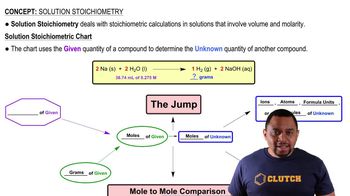Some metals occur naturally in their elemental state while others occur as compounds in ores. Gold, for instance, is found as the free metal; mercury is obtained by heating mercury(II) sulfide ore in oxygen; and zinc is obtained by heating zinc(II) oxide ore with coke (carbon). Judging from their positions in the activity series, which of the metals sil-ver, platinum, and chromium would probably be obtained by (a) finding it in its elemental state?
Ch.4 - Reactions in Aqueous Solution
Chapter 4, Problem 139b
(b) If Ksp = 1.1 * 10-12 for Ag2CrO4, what are the molar concentrations of Ag+ and CrO4 2-in solution?
 Verified step by step guidance
Verified step by step guidance1
Identify the dissolution equation for Ag2CrO4: Ag2CrO4(s) \rightleftharpoons 2Ag^+(aq) + CrO_4^{2-}(aq).
Write the expression for the solubility product constant (K_{sp}): K_{sp} = [Ag^+]^2[CrO_4^{2-}].
Let the solubility of Ag2CrO4 be 's'. Then, [Ag^+] = 2s and [CrO_4^{2-}] = s.
Substitute the expressions for [Ag^+] and [CrO_4^{2-}] into the K_{sp} expression: K_{sp} = (2s)^2(s) = 4s^3.
Set the K_{sp} expression equal to the given K_{sp} value and solve for 's': 4s^3 = 1.1 \times 10^{-12}.

Verified video answer for a similar problem:
This video solution was recommended by our tutors as helpful for the problem above.
Video duration:
12sWas this helpful?
Key Concepts
Here are the essential concepts you must grasp in order to answer the question correctly.
Solubility Product Constant (Ksp)
The solubility product constant (Ksp) is an equilibrium constant that applies to the solubility of sparingly soluble ionic compounds. It represents the product of the molar concentrations of the ions in a saturated solution, each raised to the power of their coefficients in the balanced dissolution equation. For Ag2CrO4, Ksp = [Ag+]^2[CrO4^2-], which allows us to relate the concentrations of the ions to the Ksp value.
Recommended video:
Guided course

Solubility Product Constant
Dissociation of Ionic Compounds
Ionic compounds dissociate into their constituent ions when they dissolve in water. For Ag2CrO4, the dissociation can be represented as Ag2CrO4(s) ⇌ 2Ag+(aq) + CrO4^2-(aq). This means that for every mole of Ag2CrO4 that dissolves, two moles of Ag+ and one mole of CrO4^2- are produced, which is essential for calculating their concentrations in solution.
Recommended video:
Guided course

Ionic Compounds Naming
Stoichiometry in Solutions
Stoichiometry involves the quantitative relationships between the amounts of reactants and products in a chemical reaction. In the context of this question, it helps us determine the molar concentrations of Ag+ and CrO4^2- based on the Ksp value and the stoichiometric ratios from the dissociation equation. By setting up the relationship between the concentrations and Ksp, we can solve for the unknown concentrations.
Recommended video:
Guided course

Solution Stoichiometry
Related Practice
Textbook Question
Textbook Question
Some metals occur naturally in their elemental state while others occur as compounds in ores. Gold, for instance, is found as the free metal; mercury is obtained by heating mercury(II) sulfide ore in oxygen; and zinc is obtained by heating zinc(II) oxide ore with coke (carbon). Judging from their positions in the activity series, which of the metals sil-ver, platinum, and chromium would probably be obtained by (c) heating its oxide with coke?
Textbook Question
A sample weighing 14.98 g and containing a small amount of copper was treated to give a solution containing aque-ous Cu2+ ions. Sodium iodide was then added to yield solid copper(I) iodide plus I3 with thiosulfate, S2O3 - ion, and the I3 - was titrated 2-. The titration required 10.49 mL of 0.100 M Na2S2O3 for complete reaction. What is the mass percent copper in the sample? The balanced equations are
Textbook Question
A 100.0 mL solution containing aqueous HCl and HBr was titrated with 0.1235 M NaOH. The volume of base required to neutralize the acid was 47.14 mL. Aqueous AgNO3 was then added to precipitate the Cl-and Br-ions as AgCl and AgBr. The mass of the silver halides obtained was 0.9974 g. What are the molarities of the HCl and HBr in the original solution?
Textbook Question
A sample of metal (M) reacted with both steam and aqueous HCl to release H2 but did not react with water at room tem-perature. When 1.000 g of the metal was burned in oxygen, it formed 1.890 g of a metal oxide, M2O3. What is the iden-tity of the metal?
Textbook Question
An unknown metal (M) was found not to react with either water or steam, but its reactivity with aqueous acid was not investigated. When a 1.000 g sample of the metal was burned in oxygen and the resulting metal oxide converted to a metal sulfide, 1.504 g of sulfide was obtained. What is the identity of the metal?
